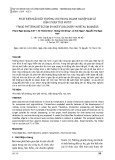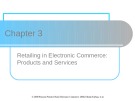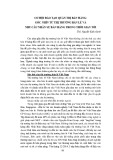
Business Division
Nguyen Chi Thanh www.conotek.com Reference
SALES MANAGEMENT BY ACTIVITIVES
I. Qualify Prospect and Understand the Business
... Profile: Identify, contact and qualify
1. Identify target account based on available profiling data.
2. Identify key decision-makers by role and specify interest-generating benefits for each one.
3. Determine entry level contact.
4. Select, by priority, methods of contact.
5. Set call objectives.
6. Mental preparation and make the contact.
7. Establish trust and rapport - Credibility building.
8. Qualify the prospect in light of this project. GO/NO GO
... Research: Understand the prospect's business to develop your sales strategy
9. Research prospects critical processes - How are they currently doing it?
10. Research prospect's future business plans.
11. Research prospect's selling environment to determine how you can help competitively
advantage them in their market place.
12. Identify our potential and/or actual competitors (including "do nothing").

Business Division
Nguyen Chi Thanh www.conotek.com Reference
13. Competitor Analysis with Unique Selling Points and Distinctive Selling Points (USP/DSP)
identified and translated into Features, Advantages and Benefits for each competitor.
14. List criteria that must be set with each decision maker to rule out competition.
15. Identify potential objections - strategies formulated/reviewed to prevent, neutralize or
respond as necessary. Identify strategic approach. GO/NO GO
16. Identify additional potential for other products/services.
17. Identify others in the organization who could potentially benefit from what you sell and the
types of benefits they might receive, but who may not be able to directly influence the sale.
II. Conduct Needs Assessment and Cost/Benefit Analysis
... Orientation: Activate the Sales Strategy
18. List areas to focus conversation based on Unique and Distinctive Selling Points (USP/DSP).
Answer the question, "What makes you different?"
19. List areas to focus conversation to neutralize potential objections.
... Symptoms: Anxiety or concerns about the not having the benefits you can offer.
20. List symptoms identified based on Unique Selling Points and/or DSPs
... Problems: Root cause problems - missing features that provide the advantages and benefits.
21. List of potential problems confirmed based on Unique and/or Distinctive Selling Points
(USP/DSP).
Effects / Consequences: (Cost - Benefit Analysis) What the problems are costing the prospect
(financially, subjectively)
22. Quantify what it costs the prospect financially and subjectively not to have the benefits of
your USP/DSPs using their facts and figures (current). Know the financial and
subjective/emotional consequences of not solving the problem (future).
Criteria / Benefits: Set minimum specifications and expectations for selecting a supplier that include
your USPs/DSPs. Identify top motivating benefits for each key decision-maker.

Business Division
Nguyen Chi Thanh www.conotek.com Reference
23. Criteria listed and agreed upon based on USP/DSP.
24. Decision maker’s benefits determined.
25. Interviews completed with key decision makers.
III. Identify Logistics to Advance the Sale
... Triggering Events: One event triggers the next. "Interim Action Plan" items identified.
26. Advise and get agreement on next steps to advance the sale.
27. Confirm cost benefit data (Effects/Consequences).
28. Outline feedback loops, milestones, measurements and follow up process.
29. Identify key contacts for feedback and ongoing support or information contacts.
30. Identify optional target dates for implementation.
31. Determine ideal starting dates to meet target dates.
32. Determine product/service availability (your ability to deliver). GO/NO GO
33. Exchange any additional data, specifications, drawings, etc.
34. Identify and arrange to meet any additional critical interactive players.
35. Identify, advise and prepare Recommenders to champion status.
36. Arrange and schedule "Beta" tests, pilot studies or other pre-purchase approvals required.

Business Division
Nguyen Chi Thanh www.conotek.com Reference
37. Identify specific end users or consumers involved in project.
38. Receive feedback from Beta, pilot or other pre-approvals.
39. Resolve any questions or issues that developed from the pre-approval process.
40. Develop product/service delivery phase-in plans.
41. Exchange financial or credit information as necessary.
42. Obtain any internal (your company) approvals as needed.
IV. Present Value Proposition
43. Prepare and submit a proposal that directly addresses the "Criteria" set (Criteria Driven
Value Proposition).
44. Conduct a Criteria Driven Presentation.
45. Prospect affirms your ability to meet criteria.
46. Final negotiations concluded.
47. Final approval on project/product/service budget received.
48. Contract/agreement signed, letter of confirmation sent.
49. Customer notifies current or competing supplier (if any).












![Đề thi Quản trị marketing kết thúc học phần: Tổng hợp [năm]](https://cdn.tailieu.vn/images/document/thumbnail/2025/20251014/elysale/135x160/24261760434715.jpg)












![Tài liệu học tập Quản trị bán hàng [mới nhất]](https://cdn.tailieu.vn/images/document/thumbnail/2025/20251009/lehanminhanh@gmail.com/135x160/59311759982292.jpg)
